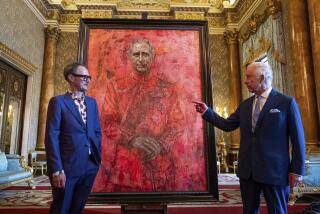Titian may have painted it after all
- Share via
WILLIAMSBURG, Va. — The man in the black velvet doublet stares through reddish, bulging eyes as he stands at a slight angle, with his left hand holding a folded, white paper and his right hand either drawing or replacing his stiletto.
Long known as the work of the great Italian Renaissance painter Titian, this somber, unsigned oil portrait of a middle-aged, 16th century Italian duke was consigned to obscurity when an art critic questioned its authenticity nearly 70 years ago.
But an art historian who has spent eight years researching it believes it is a Titian after all.
It largely comes down to a problem with numbers.
An archivist misread the Roman numerals in the date on a letter in which the duke promised a German nobleman he would have Titian paint the portrait in a diplomatic exchange, said Aaron De Groft, director of the Muscarelle Museum of Art at the College of William and Mary, where the painting is on loan.
The misinterpretation of the date as June 17, 1540, led prominent German art historian August Mayer to write in a journal in 1938 that Titian would not have had enough time to paint the duke, who died 11 days later.
That article “was like putting a big ‘X’ mark on it,” De Groft said of the painting.
But the correct date was June 17, 1539, giving Titian plenty of time, said De Groft, who based his conclusions on an examination of archival documents, scientific analysis, stylistic comparison with other Titian paintings and intuition.
De Groft studied it at the request of Thomas Dossett, a Tennessee lawyer and art collector who acquired part ownership of the painting around 1970.
Dossett did quite a bit of research on his own before approaching De Groft, who was a curator and deputy director at the Ringling Museum of Art in Sarasota, Fla. De Groft brought the painting with him to Williamsburg last year when he became director of the museum.
The man in the painting is Federico II Gonzaga, the first Duke of Mantua and the first great patron of Titian, who was known for his sense of color and his unflinching realism.
“This picture was lost almost since the moment it was created,” De Groft said. It’s not clear whether the German nobleman ever received the portrait, although it did pop up from time to time in history and was identified in owners’ inventories as a Titian, he said.
The last time it was seen publicly, before now, was in 1931, when it appeared on the cover of the Art News, announcing the sale of the collection of Hungarian art dealer Marczell von Nemes. A Pennsylvania collector paid about $30,000 for it.
Mayer wrote the sale catalog entries for the Old Master paintings and didn’t question the Titian. Then came his 1938 article. The painting languished at later auctions and was shuffled from one obscure collection to another, De Groft said.
De Groft hopes his research will help the painting be recognized as a pivotal work between Titian’s early and later styles. While the body and background may have been painted by apprentices in Titian’s workshop, De Groft said the master himself painted the face and hands.
A forensic analysis of the painting showed the pigments and varnishes to match those that Titian would have used. De Groft said this eliminates the possibility that this was a copy. X-rays showed the painting was done on a fine diamond-weave canvas, an expense indicating it was an important commission.
Parts of the painting have been overcleaned over the years, revealing a gray underpainting -- also consistent with Titian.
To have the piece accepted as a Titian would require a certain degree of consensus among Titian scholars, said Madeleine Viljoen, director of the Art Museum at La Salle University in Philadelphia and a Renaissance art scholar. She said that could boost the price from thousands of dollars to millions if the painting were to be put up for sale.
The lack of a signature isn’t necessarily a problem, since there are many paintings that Titian didn’t sign.
De Groft would like to get the painting into a Paris museum show on Titian and the courts of Europe. “It needs to be seen nose to nose with other Titian portraits of its time,” he said.
For his part, Dossett would like to see a major museum buy the painting and put it on display. “What good is the Hope Diamond if it stays in a lock box? Nobody ever sees it,” he said.
More to Read
The biggest entertainment stories
Get our big stories about Hollywood, film, television, music, arts, culture and more right in your inbox as soon as they publish.
You may occasionally receive promotional content from the Los Angeles Times.










